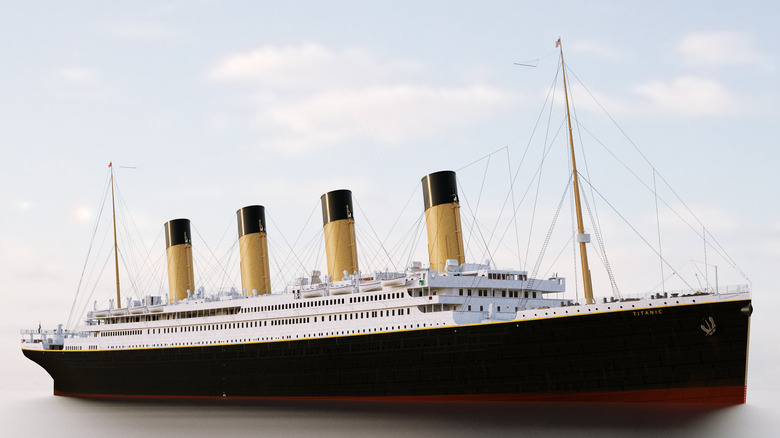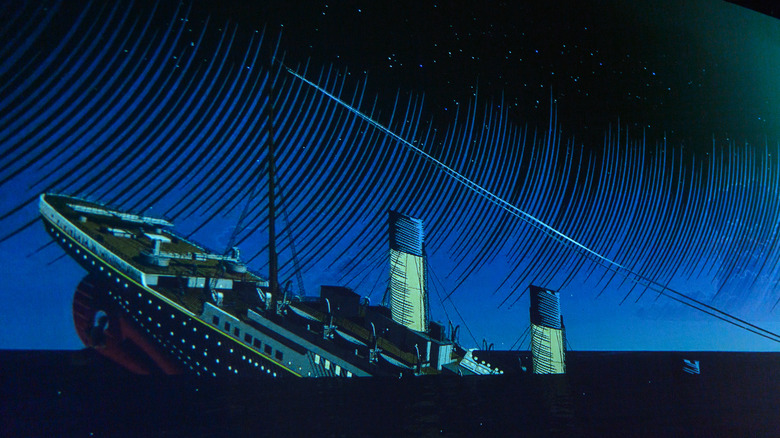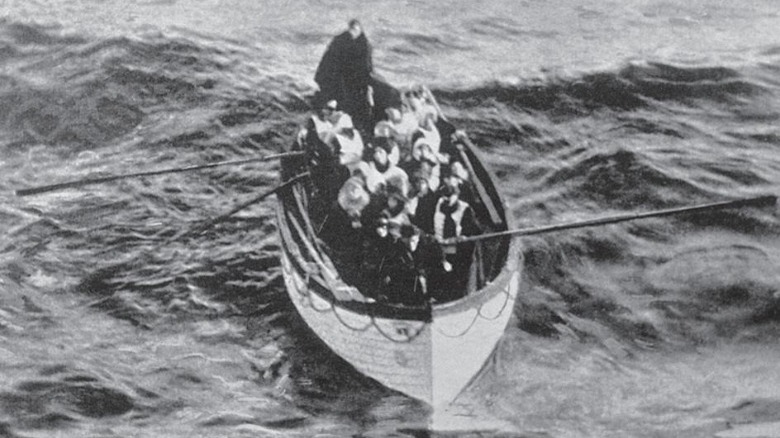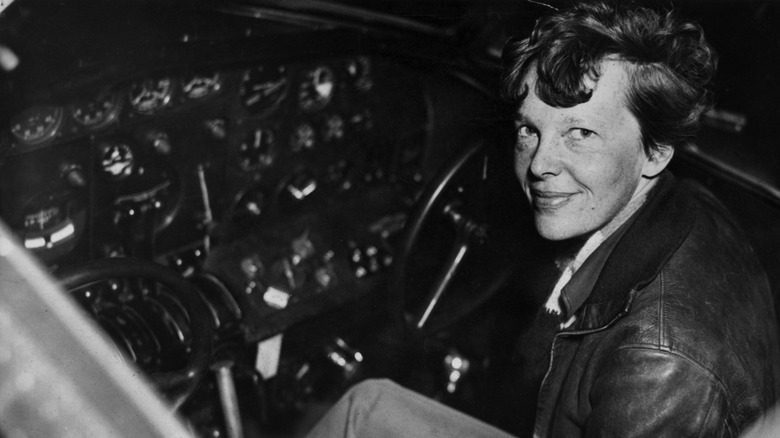Finding The Titanic Was Cover For A Top-Secret Military Operation
The story of the RMS Titanic has fascinated generations for over 100 years. On April 14, 1912, the luxury passenger liner struck an iceberg. The gigantic ship sunk over the course of two hours, taking at least 1,517 lives, roughly 70% of all people on board (via ThoughtCo.). Many are drawn to the story of a ship, billed as unsinkable, that succumbed to human error, hubris, and natural forces. The crew received warnings about icebergs, but the messages didn't reach the right people. The ship's manufacturers made the supposedly water-tight compartments with low-quality materials that buckled upon impact with the iceberg (per Britannica). After the boat sank, the remaining passengers and crew treading the cold waters froze to death quickly (via ThoughCo.).
The Titanic took the lives of some of the age's most wealthy and notable figures: John Jacob Astor IV; Isidor and Ida Straus, owners of the Macy's Company. Their deaths reminded the world that the mighty could also fall. Furthermore, the tragedy includes compelling acts of love and bravery. Famously, Isidor Straus refused a lifeboat, allowing women and children ahead of him. Ida followed suit, telling Isidor, "Where you go, I go" (per Britannica). Ida was one of many women who refused to leave their husbands and sons behind.
Recently, the Titanic's story added a new chapter, one of Cold War-era espionage. Declassified reports confirm that the discovery of the Titanic's wreckage provided a cover story for a top-secret military mission.
The search for the Titanic begins
The story of finding the Titanic's wreckage begins with the deep-sea explorer Robert Ballard (via CNN). Before the Titanic, he'd already made significant discoveries. His finds include the Galapagos Rift's thermal vents — hot-spring-like vents at the ocean floor. The breakthrough forever changed how we understand deep-sea environments (per National Geographic).
The challenge and difficulty of locating the wreck were what inspired Ballard, rather than the Titanic's story. He explained to CNN that the "Titanic was clearly the big Mount Everest at the time." He continued, "So many others had tried. Many that I thought would have succeeded, or should have succeeded but didn't."
According to CNN, his search began with an unsuccessful attempt in 1977, using human-crewed equipment. After the mission failed, he turned to robotic exploration vessels where human safety and endurance weren't factors, allowing for longer and deeper exploration times. In 1982 Ballard approached the Navy, seeking funding to build the robotic unmanned vessel, says National Geographic. Luckily, the Navy needed that same technology for their top-secret interests (via Popular Mechanics).
The military and the explorer strike a secret deal
As Ballard sought funding for his mission, the military needed a deep-water explorer and an excellent cover story, reports CNN. Ballard's search for the Titanic aligned perfectly with the Navy's plans. Two nuclear submarine wrecks, USS Thresher and USS Scorpion, rest near the Titanic in the North Atlantic Ocean. The Navy needed someone to find them (per National Geographic). At the time, the Cold War was in full force, and searching for the Titanic proved to be an excellent way to hide the mission from the then-Soviet Union, explains Popular Mechanics.
According to National Geographic, the Navy tasked Ballard with finding the sunken submarines and investigating the status of their nuclear reactors. Specifically, the Navy wanted to know if the nuclear reactors would cause any damage to the ocean's environment. Additionally, the Navy was curious about the cause of the accidents, especially whether there'd been any Russian involvement. As Ballard explained the details of his mission to CNN, "We knew where the subs were." And the Navy asked him to "go back and not have the Russians follow [him]." Moreover, the Navy was "interested in the nuclear weapons that were on the Scorpion and also what the nuclear reactors (were) doing to the environment."
Ballard's discoveries
Only after he performed the Navy's operation was Ballard allowed to use the equipment for his search for the Titanic. Because of that, he and his team worked hard to complete their mission efficiently, successfully giving themselves 12 extra days to locate the famous shipwreck, says CNN. That said, the Navy emphasized that the importance of the trip was the missiles, and they didn't expect Ballard to discover anything of use, writes National Geographic.
With speed and ease, Ballard found the submarines. His search revealed that the nuclear reactors were stable and did not affect the oceanic environment. He also concluded that the Thresher sank due to a pipe issue rather than outside interference. However, the fate of the Scorpion remains unclear, according to National Geographic.
The search for the missiles aided Ballard's discovery of the Titanic. He observed that the submarines left long debris trails, with the heaviest pieces sinking first. Ballard applied this same theory to the location of the Titanic, factoring in the oceanic currents. It turns out that the Titanic broke apart and fell just as he predicted (via National Geographic). Ballard discovered the Titanic resting 12,000 feet below the ocean's surface (per Popular Mechanics). It landed on the ocean floor about 13 nautical miles from where the distress signal was sent in 1912 (via Britannica).
A grim truth
While at first, Ballard and his crew celebrated discovering the Titanic, the reality of the tragedy soon struck. In his book "Into the Deep: A Memoir From the Man Who Found Titanic," Ballard describes the turn of mood: "Around 2 a.m., someone remarked that we were approaching the time of night when Titanic had sunk into a sea as calm as the one we had now. It wasn't until this point that the emotion of the tragedy fully hit me. I know this sounds odd, but it was quite unexpected. I had never been a Titanic groupie. Sure, I'd wanted to find it, and I'd been very competitive about that. But a world tragedy had played itself out on this spot, and now the site itself took hold of me. Its emotion filled me and never let go" (via CNN).
The Titanic's sinking is a tale of horror that involves the cruelty of life-or-death decisions. After the Titanic sank below the water, most lifeboats moved away over fears of getting swamped by those left in the water. When the lifeboats returned, most of those in the water had frozen to death. All in all, only 705 people escaped in underfilled lifeboats, reports Britannica.
Furthermore, the shipwreck displays the horrors of the class divide. Only 174 out of the 710 people in third-class cabins survived. Yet, the hardest-hit population was the working crew members. Nearly 80% of those working on board died, while 45% of first and second-class passengers perished.
A cover-up and Ballard's next mission
The fact that Ballard had discovered the Titanic came as a surprise to the Navy. Quickly, all involved solidified their cover story. Ballard explains, "the Navy never expected me to find the Titanic, and so when that happened, they got really nervous because of the publicity. ... But people were so focused on the legend of the Titanic they never connected the dots" (per National Geographic). The cover story worked, and in 1985, The New York Times reported that Ballard had stumbled upon the wreck while testing his new research equipment. Those involved with the project conceded that the military might use the equipment for classified military projects in the future. Quotes mention missiles but emphasize that nothing classified was involved with the Titanic mission.
In 2008, the Navy declassified details regarding Ballard's mission, and he could tell the world the true story. Ballard continues to stay mum as to whether he's participated in any other top-secret mission, says National Geographic. Only time will tell what new information the military will declassify and what other truths will surface. Ballard stated, "I cannot talk about my other Navy missions, no." He elaborated, "They have yet to be declassified" (via CNN).
In 2019, Ballard began searching for Amelia Earhart's airplane wreck. He remains optimistic about what he may find. He told CNN, "When kids ask me 'what's your greatest discovery,' I always tell them 'it's the one that I'm about to make.'"





